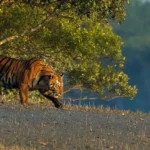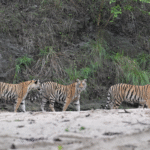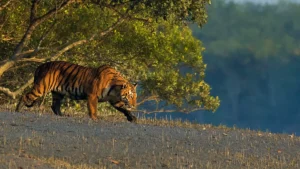Sundarbans Tiger Safari 2025: Complete Travel & Safari Guide
Megha

Excited to Meet Royal Bengal Tiger?
Discover the infamous magnificence of nature and get to see the rare Royal Bengal Tiger is once-in-a-lifetime opportunity in the Sundarbans. Experience this biggest mangrove forest in the world and a UNESCO World Heritage Site – The Sundarban Tiger Reserve. In 2025, a Sundarbans safari combines cultural immersion, adventure, and wildlife. Dense forests meet the powerful deltas of three rivers to form this estuarine mangrove environment. The Sundarbans, a mysterious mangrove maze that stretches into the Bay of Bengal at the meeting point of the Ganges, Brahmaputra, and Meghna rivers, is a masterpiece of nature. The biggest tidal halophytic mangrove forest in the world, this World Heritage Site is where wildness and water merge to form a single, seamless area.
Where Can You Meet Them?
The biggest contiguous mangrove forest in the world is the Sundarbans Reserve Forest (SRF), which is situated in southwest Bangladesh, next to the Bay of Bengal, between the Baleswar River in the east and the Harinbanga River in the west. The confluence of the Ganges, Brahmaputra, and Meghna rivers created the Sundarbans, which are located in the delta region of southern Bangladesh and West Bengal, India. Tiger Reserve and Sundarbans National Park are located on the Indian side.
How Can You Reach There?
Start from Kolkata and travel 2 hours (54 km) to Canning by car or train. From Canning, shared vans take you to Godkhali Jetty, the gateway to boat safaris into the Sundarbans
Home to the exclusive and legendary Royal Bengal Tiger, the Sundarbans is not just a forest—it’s a living, breathing ecosystem. These swimming tigers roam a maze of creeks, muddy estuaries, and dense forest. The park also shelters saltwater crocodiles, spotted deer, Ganges river dolphins, and over 260 species of birds.
But it’s not just about wildlife Tiger Safari. The Sundarbans is an intricate balance of nature, resilience, and cultural folklore. Life here flows with the tides. Each boat ride is a silent passage through green cathedrals, each rustle could be the whisper of the wild.
To visit the Sundarbans is to enter a different rhythm of the planet—untamed, sacred, and spellbinding. It’s where the forest tells stories in silence and the tiger, whether seen or not, always watches.
Why Choose a Sundarbans Tiger Safari?
Unlike typical safaris, this one takes you deep into winding river channels aboard boats. It’s your best chance to spot the Royal Bengal Tiger in its watery habitat.
Types of Safari Experiences in Sundarbans
- Boat Safaris – Navigate rivers bordered by dense mangroves.
- Overnight Houseboat Tours – Multi-day tours with accommodation on board.
- Eco-village Stays – Explore local life and culture along with wildlife tours.
Expecting the Best: Flora & Fauna of the Sundarbans
Expect sightings of crocodiles, fishing cats, spotted deer, mudskippers, and over 250 bird species. Mangrove species like Sundari trees dominate the landscape.
Tips for Sundarbans Safari – We’ve Got You Covered
- Travel between November and March for the best wildlife spotting.
- Carry insect repellent, binoculars, sunscreen, and light cotton clothes.
- Always prefer registered tour operators for safety and permits.
Conclusion:
A Sundarbans tiger safari is not just a wildlife tour but an exploration into one of the planet’s most unique ecosystems. With its tranquil rivers winding through dense mangrove forests, sightings of rare and majestic wildlife like the Royal Bengal Tiger, and immersive boat journeys, it offers a blend of serenity and thrill unlike any other destination. The region’s natural beauty, ecological richness, and raw wilderness make it an unforgettable escape into nature’s heart. Whether you’re a seasoned traveler or a curious explorer, a journey into the Sundarbans promises to be an awe-inspiring chapter in your travel story, a must-do for nature lovers, photographers, and adventure seekers alike.





